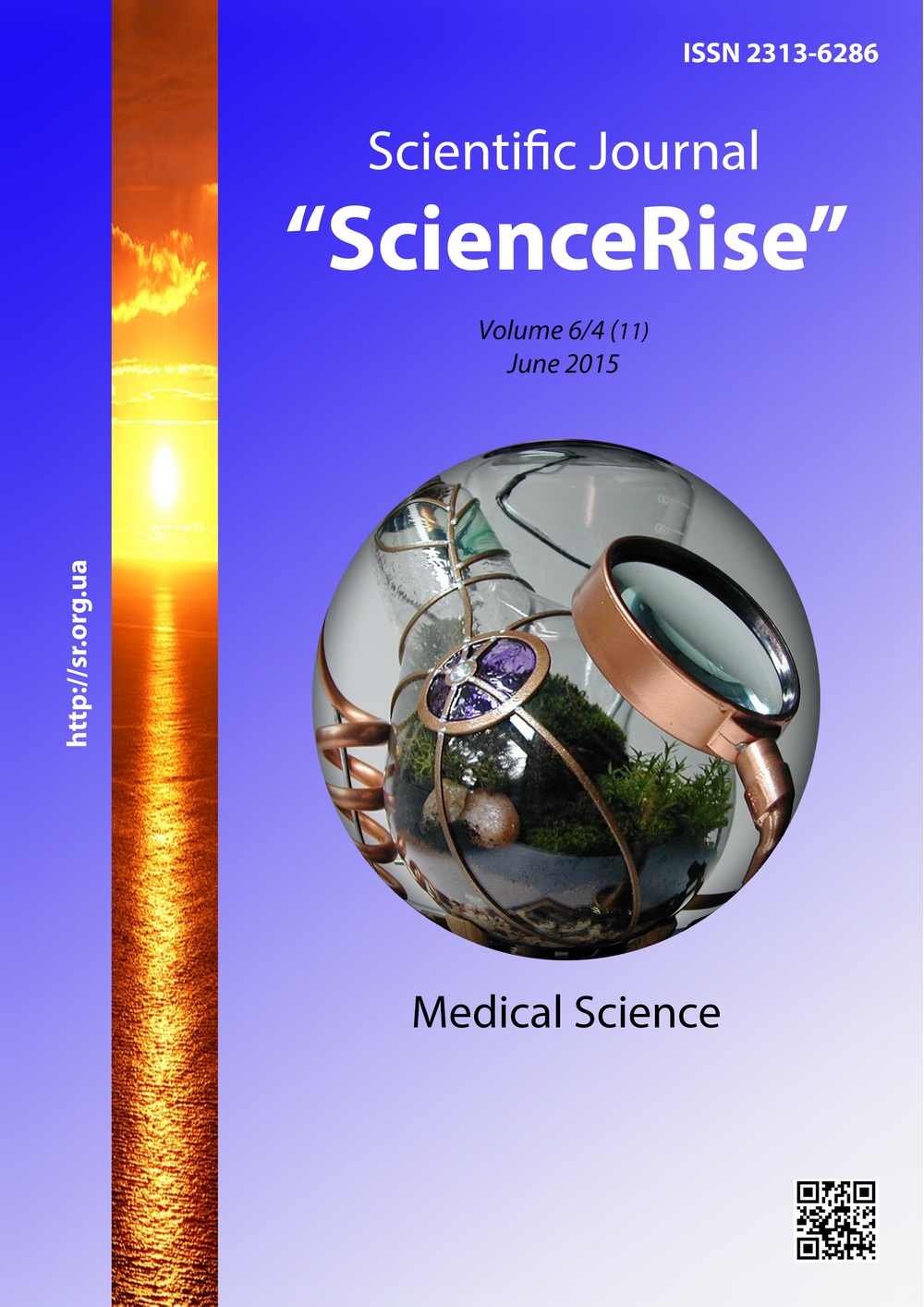The value of comorbidity for stratification of an acute myeloid leukemias treatment in adults
DOI:
https://doi.org/10.15587/2313-8416.2015.45466Keywords:
acute myeloid leukemia, prognosis, treatment stratification, comorbidity, Charlson index, survivabilityAbstract
The aim of research is to define an impact of comorbidity on an effectiveness of an AML treatment and general and recurrence-free survivability
Materials and methods. For solving this problem we analyzed medical histories of 97 patients with AML. Charlson index of comorbidity was used for defining an occurrence and severity of the contaminant pathology in patients with AML. The sum value of the number and severity of the contaminant diseases that is equal to 0 – 2, 3 – 5 points and more than 5 points corresponded to the low, intermediate or a high index of comorbidity. 2 types of an inductive chemotherapy were carried out as a first line: the courses «7+3» and FLAG that defined 2 groups of observation.
Results and discussion. In the group of patients who were treated by the FLAG scheme were twice more patients with a low comorbidity index (0-2 points) (62 % opposite 31 %). The best general and recurrence-free survivability was ascertained in patients with a low comorbidity index (0-2 point)s and at presence of cytogenetic anomalies corresponding to the group of favorable prognosis. Moreover it was established that patients received an inductive chemotherapy (CT) by the FLAG system have a lower risk of recurrence or progression of AML.
Conclusions. The high comorbidity index is a significant risk of recurrence or AML progression, reliably increases risk of death and worsens general and recurrence-free survivability. At AML treatment stratification with a glance to comorbidity index the prognosis of disease and general survivability increases
References
Grimwade, D., Hills, R. K. (2009). Independent prognostic factors for AML outcome. Hematology, 2009 (1), 385–395. doi: 10.1182/asheducation-2009.1.385
Etienne, A., Esterni, B., Charbonnier, A., Mozziconacci, M.-J., Arnoulet, C., Coso, D. et. al. (2007). Comorbidity is an independent predictor of complete remission in elderly patients receiving induction chemotherapy for acute myeloid leukemia. Cancer, 109 (7), 1376–1383. doi: 10.1002/cncr.22537
Sorror, M. L., Maris, M. B., Storb, R. et al. (2005). Hematopoietic cell transplantation (HCT)-specific comorbidity index: a new tool for risk assessment before allogeneic HCT. Blood, 106 (8), 2912–2919. doi: 10.1182/blood-2005-05-2004
Sorror, M. L., Sandmaier, B. M., Storer, B. E., Maris, M. B., Baron, F., Maloney, D. G. et. al. (2007). Comorbidity and Disease Status Based Risk Stratification of Outcomes Among Patients With Acute Myeloid Leukemia or Myelodysplasia Receiving Allogeneic Hematopoietic Cell Transplantation. Journal of Clinical Oncology, 25 (27), 4246–4254. doi: 10.1200/jco.2006.09.7865
Porta, M. G. D., Malcovati, L. (2009). Clinical relevance of extra-hematologic comorbidity in the management of patients with myelodysplastic syndrome. Haematologica, 94 (5), 602–606. doi: 10.3324/haematol.2009.005702
Zajrat'janc O. V., Kakturskij L. V. (2008). Formulirovka i sopostavlenie klinicheskogo i patologoanatomicheskogo diagnozov. Moscow.
Pal'cev M. A., Avtandilov G. G., Zajrat'janc O. V., Kakturskij L. V., Nikonov E. L. (2006). Oformlenie diagnoza. Moscow.
Vertkin, A. L., Rumjancev, M. A., Skotnikov, A. S. et. al. (2011). Komorbidnost'. Vestnik semejnoj medicin, 3, 40–47.
Charlson, M. E., Pompei, P., Ales, K. L., MacKenzie, C. R. (1987). A new method of classifying prognostic comorbidity in longitudinal studies: Development and validation. Journal of Chronic Diseases, 40 (5), 373–383. doi: 10.1016/0021-9681(87)90171-8
Campbell-Scherer, D. (2010). Multimorbidity: a challenge for evidence-based medicine. Evidence-Based Medicine, 15 (6), 165–166. doi: 10.1136/ebm1154
Leith, C. P., Kopecky, K. J., Chen, I. M. et al. (1999). Frequency and clinical significance of the expression of the multidrug resistence proteins MDR1/P-glicoprotein, MRP1, and LRP in acute myeloid leukemia: A Southwest Oncology Group Study. Blood, 94, 1086–1099.
Leith, C. P., Kopecky, K. J., Godwin, J. et al. (1997). Acute myeloid leukemia in the elderly: assessment of multidrug resistance (MDR1) and cytogenetics distinguishes biologic subgroups with remarkably distinct responses to standard chemotherapy: a Southwest Oncology Group study. Blood, 89, 3323–3329.
De Groot, V., Beckerman, H., Lankhorst, G., Bouter, L. (2004). How to measure comorbidity: a critical review of available methods. Journal of Clinical Epidemiology, 57 (3), 323. doi: 10.1016/j.jclinepi.2003.09.002
Rozzini, R., Frisoni, G. B., Ferrucci, L., Barbisoni, P., Sabatini, T., Ranieri, P., Guralnik, J. M., Trabucchi, M. (2002). Geriatric Index of Comorbidity: validation and comparison with other measures of comorbidity. Age and Ageing, 31 (4), 277–285. doi: 10.1093/ageing/31.4.277
Vardiman, J. W., Thiele, J., Arber, D. A., Brunning, R. D., Borowitz, M. J., Porwit, A. et. al. (2009). The 2008 revision of the World Health Organization (WHO) classification of myeloid neoplasms and acute leukemia: rationale and important changes. Blood, 114 (5), 937–951. doi: 10.1182/blood-2009-03-209262
Löwenberg, B., Ossenkoppele, G. J., van Putten, W., Schouten, H. C., Graux, C., Ferrant, A. et. al. (2009). High-Dose Daunorubicin in Older Patients with Acute Myeloid Leukemia. New England Journal of Medicine, 361 (13), 1235–1248. doi: 10.1056/nejmoa0901409
Gricaev, S. V., Martynkevich, I. S., Martynenko, L. S. et. al. (2010). Sravnitel'nyj analiz kariotipa pozhilyh bol'nyh mielodisplasticheskim sindromom i ostrym mieloidnym lejkozom. Klinicheskaja onkogematologija, 2, 114–118.
Downloads
Published
Issue
Section
License
Copyright (c) 2015 Надежда Валерьевна Горяинова

This work is licensed under a Creative Commons Attribution 4.0 International License.
Our journal abides by the Creative Commons CC BY copyright rights and permissions for open access journals.
Authors, who are published in this journal, agree to the following conditions:
1. The authors reserve the right to authorship of the work and pass the first publication right of this work to the journal under the terms of a Creative Commons CC BY, which allows others to freely distribute the published research with the obligatory reference to the authors of the original work and the first publication of the work in this journal.
2. The authors have the right to conclude separate supplement agreements that relate to non-exclusive work distribution in the form in which it has been published by the journal (for example, to upload the work to the online storage of the journal or publish it as part of a monograph), provided that the reference to the first publication of the work in this journal is included.

